Abstract
Objectives
This study aimed to clarify the relationship between the panoramic radiographic appearance and the longitudinal cone-beam computed tomography (CBCT) classification of root configurations of the mandibular second molar.
Methods
Panoramic radiographs of 1058 mandibular second molars were classified into five types according to the number and configuration of the roots. These molars were also examined with CBCT at four levels between the pulp chamber and the root apex, and axial images perpendicular to the root axis were categorized into three patterns: single (fused root with small grooves on both buccal and lingual sides or a round root with one canal); double (two separate roots with a trabecular appearance between them); and C-shaped (root with a deep groove opening only on the lingual or buccal side relative to the opposite side). Based on these patterns and their scan levels, the CBCT root morphology appearance in each tooth unit was classified into seven groups. Relationships were investigated between these seven CBCT groups and the five panoramic root types.
Results
In panoramic types 1 and 2 (with separate roots), 85% had roots with a double pattern (groups II and III) on the CBCT images. In panoramic types 3 and 4 (with fused roots), 85% had C-shaped CBCT patterns at the lower scan levels.
Conclusions
When panoramic images show fused root types, CBCT examinations should be planned to clarify the root canal configuration.







Similar content being viewed by others
References
Kato A, Ziegler A, Higuchi N, Nakata K, Nakamura H, Ohno N. Aetiology, incidence and morphology of the C-shaped root canal system and its impact on clinical endodontics. Int Endod J. 2014;47:1012–33.
Jafarzadeb H, Wu YN. The C-shaped root canal configuration: a review. J Endod. 2007;33:517–23.
Fukuya T. A morphological study on gutter shaped root tooth. J Kyushu Dent Soc. 1976;29:557–76 (in Japanese).
Kotoku K. Morphological studies on the roots of the Japanese mandibular second molars. Shikwa Gakuho. 1985;85:43–64 (in Japanese).
Zheng Q, Zhang L, Zhou X, Wang Y, Tang L, Song F, et al. C-shaped root canal system in mandibular second molars in a Chinese population evaluated by cone-beam computed tomography. Int Endod J. 2011;44:857–62.
Zhang R, Wang H, Tian YY, Yu X, Hu T, Fummer MH. Use of cone-beam computed tomography to evaluate root and canal morphology of mandibular molars in Chinese individuals. Int Endod J. 2011;44:990–9.
Seo MS, Park DS. C-shaped root canals of mandibular second molars in a Korean population: clinical observation and in vitro analysis. Int Endod J. 2004;37:139–44.
Jin GC, Lee SJ, Rob BD. Anatomical study of C-shaped canals in mandibular second molars by analysis of computed tomography. J Endod. 2006;32:10–3.
Fan B, Cheung GS, Fan M, Gutmann JL, Bian Z. C-shaped canal system in mandibular second molars: Part I—anatomical features. J Endod. 2004;30:899–903.
Fan B, Cheung GS, Fan M, Gutmann JL, Fan W. C-shaped canal system in mandibular second molars: part II—radiographic features. J Endod. 2004;30:904–8.
Melton DC, Krell KV, Fuller MW. Anatomical and histological features of C-shaped canals in mandibular second molars. J Endod. 1991;17:384–8.
Fan W, Fan B, Gutmann JL, Cheung GS. Identification of C-shaped canal in mandibular second molars. Part I: Radiographic and anatomical features revealed by intraradicular contrast media. J Endod. 2007;33:806–10.
Fan B, Gao Y, Fan W, Gutmann JL. Identification of C-shaped canal in mandibular second molars. Part II: the effect of bone image superimposition and intraradicular contrast medium on radiograph interpretation. J Endod. 2008;34:160–5.
Fan W, Fan B, Gutmann JL, Fan M. Identification of C-shaped canal in mandibular second molars. Part III: anatomic features revealed by digital subtraction radiography. J Endod. 2008;34:1187–90.
Jung HJ, Lee SS, Huh KH, Yi WJ, Heo MS, Choi SC. Predicting the configuration of a C-shaped canal system from panoramic radiographs. Oral Surg Oral Med Oral Pathol Oral Radiol Endod. 2010;109:e37–41.
Sinanoglu A, Helvacioglu-Yigit D. Analysis of C-shaped canals by panoramic radiography and cone-beam computed tomography: root-type specificity by longitudinal distribution. J Endod. 2014;40:917–21.
Gaeta-Araujo H, Fontenele RC, Nascimento EHL, Nascimento MCC, Freitas DQ, Oliveira-Santos C. Association between the root canal configuration, endodontic treatment technical errors, and periapical hypodensities in molar teeth. A cone-beam computed tomography study. J Endod. 2019;45:1465–71.
Hayashi T, Arai Y, Chikui T, Hayashi-Sakai S, Honda K, Indo H, et al. Clinical guidelines for dental cone-beam computed tomography. Oral Radiol. 2018;34:89–104.
Acknowledgements
We thank Edanz Group (www.edanzediting.com/ac) for editing a draft of this manuscript.
Author information
Authors and Affiliations
Corresponding author
Ethics declarations
Conflict of interest
The all authors declare that they have no conflict of interest in regard to the research described in this study.
Human rights statement
All procedures followed were in accordance with the ethical standards of the responsible committee on human experimentation (institutional and national) and with the Helsinki Declaration of 1964 and later versions.
Animal rights statement
This article does not contain any studies with animal subjects performed by any of the authors.
Additional information
Publisher's Note
Springer Nature remains neutral with regard to jurisdictional claims in published maps and institutional affiliations.
Rights and permissions
About this article
Cite this article
Funakoshi, T., Shibata, T., Inamoto, K. et al. Cone-beam computed tomography classification of the mandibular second molar root morphology and its relationship to panoramic radiographic appearance. Oral Radiol 37, 494–501 (2021). https://doi.org/10.1007/s11282-020-00486-3
Received:
Accepted:
Published:
Issue Date:
DOI: https://doi.org/10.1007/s11282-020-00486-3




